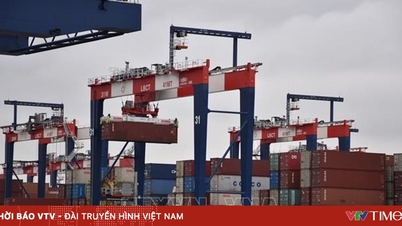
View of a cargo port in Tianjin, China. (Photo: THX/TTXVN)
China's exports unexpectedly fell in October, marking the sharpest decline since February, amid weaker overseas demand and renewed trade tensions with the United States after months of volatility.
China's exports fell 1.1% in October from a year earlier, reversing an 8.3% increase in September and against a Reuters poll forecast of a 3% increase, according to data released by the General Administration of Customs on November 7. This was the first decline in exports since February 2025 and the sharpest decline in eight months.
That was partly due to a higher base in October, when Chinese factories ramped up overseas shipments in anticipation of Donald Trump’s return to the White House and tighter tariffs. Meanwhile, imports rose just 1%, significantly slower than the previous month’s 7.4% increase and the forecast 3.2% increase.
Tensions between the world’s two largest economies escalated in early October when Trump threatened to impose an additional 100% tariff on Chinese goods in response to China’s expansion of controls on rare earth exports. However, the atmosphere cooled somewhat after Trump and President Xi Jinping met in South Korea last week, when the two sides agreed to extend the trade war truce for another year, which was due to expire on November 10.
Under the new deal, the US will halve additional tariffs on Chinese goods to 10%, while China will ease restrictions on rare earth technology exports and remove additional tariffs on US agricultural products, including soybeans – an important commodity for US farmers, a core political support base for Mr. Trump.
Still, Chinese exports to the US face an average tariff of about 45%, well above the 35% threshold that many experts say is enough to wipe out manufacturers’ profits. Economists estimate that the loss of the US market has reduced China’s export growth by about 2 percentage points, or 0.3% of GDP.
In the first 10 months of 2025, China's total import and export turnover reached 37.31 trillion yuan (equivalent to 5.27 trillion USD), up 3.6% year-on-year, but slowing down from the 4% increase in the first 9 months of the year. In October alone, the total import and export value only increased by 0.1% year-on-year, showing that the trade recovery momentum remains fragile.
Amid global trade pressure and weakening external demand, China is looking to diversify its export markets to reduce its dependence on the US. However, many businesses say they have to accept lower profit margins when selling to other regions to maintain market share. At the same time, a large trade surplus with many countries has also made China face trade protectionism from partners, worried that cheap goods could flood the market. To cope, China has just announced an initiative to increase imports, with the goal of turning the country into “ the world’s best export destination” and “expanding mutually beneficial cooperation”. China’s trade surplus in October 2025 reached 90.07 billion USD, almost unchanged from the previous month (reaching 90.45 billion USD) but lower than the forecast of 95.6 billion USD.
Weak domestic demand remains a major obstacle. China said it will raise the share of household consumption in GDP “significantly” over the next five years, according to the economic and policy guidelines for 2026–2030 set out at the recent Fourth Plenum of the Central Committee.
Source: https://vtv.vn/xuat-khau-trung-quoc-bat-ngo-sut-giam-manh-trong-thang-10-100251107154036846.htm






![[Photo] Da Nang: Hundreds of people join hands to clean up a vital tourist route after storm No. 13](https://vphoto.vietnam.vn/thumb/1200x675/vietnam/resource/IMAGE/2025/11/07/1762491638903_image-3-1353-jpg.webp)





































































































Comment (0)